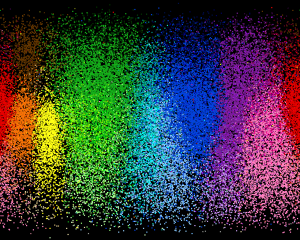 I love the curve, the sparkle, of the English language. Especially when used properly.
I love the curve, the sparkle, of the English language. Especially when used properly.
They say French is a colorful language, as is Spanish. If one uses their words wisely, all languages have beautiful ebbs and flows to them.
Today I was working on an arts and crafts catalog, and came along the glazes section. There were layers of descriptions, of ways to describe the colors. The first layer was the simplest of words: blue, gray, red, pink, purple. Even though we have different opinions on exactly what kind of blue we want, the color swatches were indeed blue and red and gray. Sometimes simplicity works.
Then there’s the second level. Words that are associated with things rather than what it is. Caramel, raspberry, grape, carrot, cinnamon. Who doesn’t know what colors those represent?
The third level was a little more imaginative. Sour Apple, Orkid, Tuscan Red, Pink-a-boo, Wine About It, Cara Bein Blue. You get the gist from title of what the color is. A colorful play on words, to be sure.
Then come the descriptions that stretch your imagination. Snapdragon. Hawaiian Sand. Granada. Sunset Jewel. Strawberry Fields. Yellow Universe. Snow Fire. You kind of know what those colors should be, but you need to check the swatches to be sure. These words leave a lot to the imagination. When I looked up Snapdragon, it was pink and yellow on cream. When I looked up Hawaiian Sand it was black and white and blue. Once my comprehension made sense of it all, the names of the colors shimmered on their own wavelength.
How do you know when to expand your vocabulary, and when to keep it simple?
One trick is to read your sentence(s) out loud. Some words are made to be read in the quiet recesses of your mind. Others are made to read aloud, savoring the alliteration or the rhyming or the pure creativity of the sentence. J.R.R. Tolkien’s The Fellowship of the Ring or George Martin’s A Feast of Crows may sound great being spoken by British actors, but would sound funny with a flat, Midwestern accent.
Know your audience. Too many flowery words may make them roll their eyes and pick up a magazine. Not enough description will do the same thing.
Another trick I learned was from the same arts and crafts catalog. Combining two words, one to evoke an impression, the second the color, is a clever way to leave an impression on the mind. Smokey Merlot, River Rock, Burnt Jade, Weathered Copper, Rustic Mustard, Roasted Eggplant — the combinations are endless. Look at the scene you’re writing, and pull something from the atmosphere and add it to your color.
Read other novels, short stories, and poetry. You will be surprised what phrases and words will call you. When they do, write them down. I have a notebook full of descriptions and words that I thought were lovely, colorful, dramatic, descriptive. I might never use them, but I could get the feel of them.
Use the thesaurus. Sparingly. There is nothing wrong with finding other words for your more mundane ones, but readers can tell if you just picked one off the page or if you thought about it. Make sure the “new” word you use flows along with the rest of them.
And don’t be afraid to make up your own words. I know that’s against most writing rules, but if you have a character that fits the description, use it. If it all flows like the bubbling stream, no one will care. For example, I have a quirky, pretzelly, smart heroine who is an astralologer. A combination of an astronomer and astrologer. Looks weird, but once you get to know her it fits her like a glove.
Colors are everywhere. Learn to describe them, or better yet, let them describe themselves.
You are so kind, Carol. I seem to be learning new tricks for my old writing habits all the time. And if they can work for a pretzel like me, it can certainly work for others!
LikeLiked by 1 person
A very insightful post, Claudia. I particularly liked your saying: pull something from the atmosphere and add it to your color. I must remember this.
I also like how you moved from one level to the next. 🙂
LikeLike
Some of them are so way out you have no idea where they came up with the name! But just think of those colors described in a story somewhere…like Sunset Jewel. It could even be someone’s name!
LikeLiked by 1 person
I know! How about rustic mustard? What color is that? I know it would fit in a fun description somewhere.
LikeLiked by 1 person
I’ve always really enjoyed the process of picking a new paint for a room. Half the fun is reading the names. I wonder how they come up with all those amazing (or ridiculous) names!
LikeLike
Snapdragon and Hawaiian sand—Ha, I’m so tempted to use those in my fiction. Love the way they sound.
I’m with you on making up words. Sometimes it’s perfect for a character to do so. Plus, it gives a bit of originality to the work, as long as it’s not overdone.
LikeLike